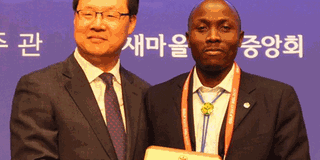Ugandan wins global anti-poverty award

Standing out. Mr Silver Isingoma receives the Global Saemaul award in South Korea last week. COURTESY PHOTO
What you need to know:
- Awarded. Mr Silver Isingoma is recognised for promoting South Korea’s community development model.
South Korea. A Ugandan farmer has been recognised for promoting South Korea’s Saemaul Undong (SMU) model that empowers rural communities to fight poverty.
Mr Silver Isingoma, the village leader of the Kitanga SMU project in Kibaale District, was recognised at last week’s 4th Global Saemaul Leadership Forum in South Korea.
The SMU concept, adopted in South Korea in 1970, is a community development approach that recognises a village as a unit of development, which promotes self-help and collaboration.
Mr Isingoma, 33 presented a paper at the forum, showcasing Kitanga Village’s SMU model and how he has spearheaded a campaign to empower the people in his community.
Kitanga Village is in Bubango Sub-county, Kibaale District, with a population of 900 people and 250 households.
Speaking to Daily Monitor after receiving his accolade, Mr Isingoma, 33, said he sacrificed his comfort in Kampala in 2015 to settle in his home village and change it for the better.
His story
The people of Kibaale District are predominantly peasants who depend on agriculture for a living with high illiteracy rates.
“The population was wallowing in poverty and my first target was to mobilise fellow youth in forming groups. First, we constructed a semi-permanent structure where we would hold meetings. This place acted as a meeting place for socialisation,” he said.
Mr Isingoma says he was then approached by a friend, Sylvester Aliguma, who introduced him to the SMU concept with principles aimed at empowering the youth financially and getting them out of poverty.
“People always wanted to share either project money or implements given by the government among themselves. They never focused on implementing the introduced programmes,” he says.
After the introduction of SMU to Kitanga village through training and small scale self-help projects, Mr Isingoma said villagers’ mindsets towards wrok have changed.
In two years of implementing the project, the SMU village membership has grown from 30 to 250 active members.
“Under the initiative, we have managed to open and maintain one 8km access road, opened and maintained two water source projects and established the SMU village banking project, where residents have contributed $2,800 (about Shs10m),” he said.
Transformation
The community has also embraced projects such as bricklaying, poultry and goat rearing. They hope to establish a vocational education institute, health centres, village banks and agricultural produce processing facilities. They also intend to disseminate proper agricultural technologies and good cropping systems for increased production.
According to Ms Barbara Barungi, South Korea’s SMU coordinator in Uganda, the concept was launched in Uganda 10 years ago and has been extended to only eight of the 123 districts in the country.
They are Mityana, Masaka, Mpigi, Buikwe, Tororo, Luuka, Maracha and Kibaale. Mr Ian Kyeyune, the SMU leader for Uganda, testified how Uganda had benefitted from SMU with funding from the South Korean government.
The minister of Local Government, Mr Tom Butime, who led the Ugandan delegation, appealed to the South Korean government to extend the project to other districts.
HOW SOUTH KOREA’S Saemaul Undong MODEL OPERATES
The Saemaul Undong, also known as the New Community Movement, New Village Movement, Saemaul Movement or Saema’eul Movement, was a political initiative launched on April 22, 1970, by South Korean president Park Chung-hee to modernise the rural South Korean economy.
Under the SMU concept, villagers living in the same communities identify their community needs to promote a common goal through self-help and cooperation. The communities are taught to live together and to cooperate towards a common goal and to devise means of uplifting their lives through community work. The SMU model left an indelible mark in Korea’s social development and a number of developing countries that include Burundi, Papua New Guinea, Bangladesh, Hondorus and Congo, among others, have embraced the model.




